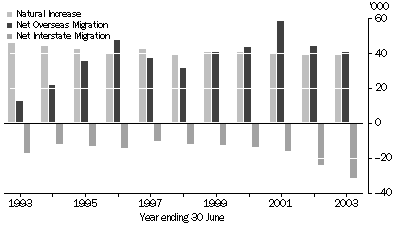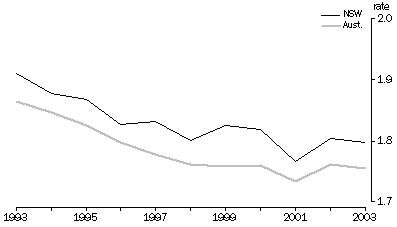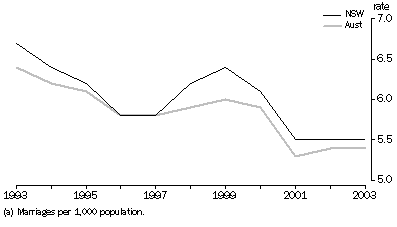|
|
POPULATION
BIRTHS AND CONFINEMENTS
DEATHS
MIGRATION
MARRIAGES
DIVORCES
OVERVIEW
This electronic product provides a demographic overview of New South Wales, 2003. It contains summary tables and commentary on trends in the components of population change including births, deaths and migration. Marriages, divorces, estimated resident population and various demographic rates are also presented. Population and migration data are for the year ended 30 June 2003, while births, deaths, marriages and divorces data are for the year ended 31 December 2003.
For comparisons between the states and territories of Australia, please refer to Demography, Australia, 2003 (cat. no. 3311.0.55.001). Demography publications for each state and territory can be accessed from the following links:
Additional state demographic data are also available from publications and data cubes linked at the foot of this page. The Demography Theme Page provides links to other Australian as well as international demographic statistics. The National Regional Profiles provide economic and social statistics of Statistical Local Areas and Local Government Areas of Australia.
INQUIRIES
For further information about these and related statistics, contact the National Information and Referral Service on 1300 135 070 or Alan Jenner on Sydney (02) 9268 4113.
SUMMARY COMMENTARY
INTRODUCTION
At 30 June 2003, the estimated resident population of New South Wales (NSW) was 6,682,000. In the 12 months to 30 June 2003, the NSW population increased by 47,900 persons or 0.7%. This was lower than the ten year average annual growth rate of 1.1% and included a natural increase of 38,800 persons and a net overseas migration gain of 40,900 persons. Both natural increase and net overseas migration increases were the lowest in the last ten years. There was also a net interstate migration loss of 31,800 persons. This loss was the highest in the previous ten years.
The NSW total fertility rate for the calendar year of 2003 was 1.80 births per woman, a slight decline on the 2002 rate. The median age of mothers of first nuptial births in NSW continued its rise, to 30.1 years in 2003. Life expectancy at birth in NSW in 2003 was 77.7 years for males and 82.9 years for females, representing increases of 2.8 years and 2.1 years respectively on the life expectancies at birth in 1993.
POPULATION
At 30 June 2003, the estimated resident population of NSW was 6,682,000 persons, accounting for 34% of the Australian resident population. NSW had an estimated increase of 47,900 persons in the previous 12 months, an annual growth rate of 0.7%. This was lower than both the 2003 national growth rate of 1.2% and the annual growth rate for NSW of 0.9% in 2002.
The increase in NSW's population comprised a natural increase (births minus deaths) of 38,800 persons, a net overseas migration gain of 40,900 persons and a net interstate migration loss of 31,800 persons. Since 1997, NSW has continued to experience an increase in the level of interstate migration loss, from a loss of 10,700 in 1997 to a loss of 31,800 in 2003. Both natural increase and net overseas migration levels have declined since 2002.
POPULATION COMPONENTS, New South Wales - 1993-2003

POPULATION, New South Wales - Selected years at 30 June |
|
 |  |  | 1993 | 2002 | 2003 |
|
| Estimated resident population | ('000) | 6,004.9 | 6,634.1 | 6,682.1 |
| Components of population change(a) |  |  |  |  |
 | Natural increase(b) | no. | 46,173 | 38,912 | 38,814 |
 | Net overseas migration(c) | no. | 12,628 | 44,411 | 40,919 |
 | Net interstate migration | no. | -17,535 | -24,430 | -31,790 |
| Total increase(d) | no. | 42,311 | 58,893 | 47,943 |
| Annual growth rate | % | 0.71 | 0.90 | 0.72 |
| Estimates resident households(e) | ('000) | 2,173.3 | (f)nya | (f)nya |
|
| nya not yet available |
| (a) From previous year. |
| (b) Births and deaths figures used to compile natural increase for population estimates are based on year of occurrence and may differ from births and deaths data based on year of registration displayed in the Births and Confinements and Deaths sections of this table. |
| (c) Until 1997 net overseas migration data for Jervis Bay, Christmas Island and Cocos (Keeling) Island were randomly allocated to the states and territories. For these years the sum of the components may therefore not equal net overseas migration. |
| (d) Includes intercensal discrepancy not accounted for by natural increase and net migration. |
| (e) 1993 figures are based on 1996 census, figures from 1997 on are based on 2001 census. |
| (f) Data is under review. |
BIRTHS AND CONFINEMENTS
In 2003, there were 85,900 live births registered throughout Australia to mothers whose usual residence was in NSW. A further 400 live births were registered in NSW to mothers whose usual residence was overseas. Registrations of births were 0.3% lower in NSW than 2002 (86,600) and 3% lower than in 1993 (89,400). In 2003, NSW had a crude birth rate of 12.9 births per 1,000 population, which was the second highest for any state or territory in Australia. The crude birth rate for NSW was also higher than that for Australia (12.6 births per 1,000 population).
TOTAL FERTILITY RATE
The Total Fertility Rate (TFR) for NSW in 2003 was 1.80 births per woman. This figure was above the Australian level of 1.76, but below the replacement level of 2.1 (the average number of children each woman would need to have to replace herself and her partner).
TOTAL FERTILITY RATE, Australia and New South Wales - 1993-2003

MEDIAN AGE AT BIRTH
The median age at birth for mothers continued to increase in 2003. The median age of mothers for all confinements was 30.5 years, compared to 30.3 in 2002 and 28.9 in 1993. The median age of mothers of nuptial births was 31.3 years, while the median age for fathers of nuptial births was 33.5 years. The median age of mothers of first nuptial births has continued to increase from 28.2 years in 1993, to 29.9 in 2002 and 30.1 in 2003.
BIRTHS AND CONFINEMENTS(a), New South Wales - Selected years |
|
 |  |  | 1993 | 2002 | 2003 |
|
| Live births |  |  |  |  |
 | Number | no. | 89,354 | 86,583 | 86,344 |
 | Crude birth rate(b) | rate | 14.9 | 13.1 | 12.9 |
 | Total fertility rate(c) | rate | 1.910 | 1.804 | 1.798 |
 | Net reproduction rate(d) | rate | 0.914 | 0.869 | 0.861 |
| All confinements |  |  |  |  |
 | Number | no. | 88,163 | 85,178 | 84,975 |
 | Median age of mother(e) | years | 28.9 | 30.3 | 30.5 |
| Nuptial confinements |  |  |  |  |
 | Number | no. | 67,049 | 61,213 | 61,253 |
 | Median age of mother(e) | years | 29.7 | 31.0 | 31.3 |
 | Median age of father(e) | years | 32.2 | 33.4 | 33.5 |
| First nuptial confinements |  |  |  |  |
 | Number | no. | 26,805 | 26,251 | 26,310 |
 | Median age of mother(e) | years | 28.2 | 29.9 | 30.1 |
|
| (a) Compiled on year of registration basis. |
| (b) Births per 1,000 population. |
| (c) Births per woman. |
| (d) Daughters surviving to reproductive age per woman. |
| (e) The age at which half the population is older and half is younger. |
DEATHS
In 2003, there were 46,000 registered deaths of persons usually resident in NSW, an increase of 7% from the 43,100 deaths in 1993. There were a further 100 deaths registered in NSW to persons whose usual residence was overseas. The crude death rate decreased from 7.2 deaths per 1,000 population in 1993 to 6.9 deaths per 1,000 population in 2003. The standardised death rate also decreased over the same period, from 8.0 deaths per 1,000 population in 1993 to 6.4 deaths per 1,000 population in 2003.
CRUDE DEATH RATE(a), Australia and New South Wales - 1993-2003

MEDIAN AGE AT DEATH
The median age at death has increased gradually for both males and females over the past decade. The median age at death for males (76.3 years) and females (82.6 years) in 2003 had increased by 3.5 and 3.1 years respectively since 1993. Over the past ten years, the median age at death for females has consistently remained around six years higher than that for males.
LIFE EXPECTANCY
The life expectancy at birth in 2003 was 77.7 years for males and 82.9 years for females. These figures were 2.8 and 2.1 years higher respectively than in 1993. The gap between male and female life expectancy has reduced over the 10 year period to 2003, with female life expectancy at birth in 1993 around six years higher than that for males and around five years higher in 2003.
INFANT MORTALITY
There were 400 infant deaths (those aged less than one year) registered in 2003, a decrease of 28% on the number in 1993 (550). In 2003, the infant mortality rate was 4.6 deaths per 1,000 live births. During the last decade, the only year in which the infant mortality rate was lower than in 2003 was in 1998 (4.3 deaths per 1,000 live births). The highest infant mortality rate during the same period occurred in 1993 (6.2 deaths per 1,000 live births respectively).
DEATHS(a), New South Wales - Selected years |
|
 |  |  | 1993 | 2002 | 2003 |
|
| Number | no. | 43,069 | 46,384 | 46,111 |
| Crude death rate(b) | rate | 7.2 | 7.0 | 6.9 |
| Standardised death rate(c) | rate | 8.0 | 6.6 | 6.4 |
| Median age at death(d) |  |  |  |  |
 | Males | years | 72.8 | 76.2 | 76.3 |
 | Females | years | 79.5 | 82.2 | 82.6 |
| Infant deaths |  |  |  |  |
 | Number | no. | 552 | 397 | 398 |
 | Infant mortality rate(e) | rate | 6.2 | 4.6 | 4.6 |
| Life expectancy at birth |  |  |  |  |
 | Males | years | 74.9 | 77.3 | 77.7 |
 | Females | years | 80.8 | 82.6 | 82.9 |
|
| (a) Compiled on year of registration basis. |
| (b) Deaths per 1,000 population. |
| (c) Deaths per 1,000 standard population. Standardised death rates have been revised using the 2001 standard population. |
| (d) The age at which there are as many people dying above the age as there are below it. |
| (e) Deaths per 1,000 live births. |
MIGRATION
NET OVERSEAS MIGRATION
In the 12 months to June 2003, NSW had a net overseas migration of 40,900 persons, comprising 147,300 overseas arrivals and 91,500 overseas departures. This was 8% lower than the figure in 2002 and 30% lower than the recent peak figure of 58,600 in 2001. The lowest overseas net migration figure over the last ten years was 12,600 persons in 1993. In 2003, NSW received 35% of Australia's net overseas migration. This is a decrease of 5% on the proportion received in 2002.
OVERSEAS MIGRATION, Permanent and long-term movement, New South Wales - 1993-2003

NET INTERSTATE MIGRATION
For the last ten years, NSW has experienced a net interstate migration loss. From 1992-93, the NSW loss was generally declining to a low of 10,700 persons in 1996-97. Since then, the net interstate migration loss has been increasing. In the 12 months to June 2003, NSW recorded its highest net interstate migration loss (31,800 persons). This was also the largest loss for any state or territory in 2003.
INTERSTATE MIGRATION, New South Wales - 1993-2003

MIGRATION, New South Wales - Selected years at 30 June |
|
 |  |  | 1993 | 2002 | 2003 |
|
| Overseas migration |  |  |  |  |
 | Permanent and long-term movement(a) |  |  |  |  |
 | Arrivals | no. | 84,421 | 144,441 | 147,345 |
 | Departures | no. | 58,033 | 93,101 | 91,539 |
 | Net overseas migration(b) | no. | 12,628 | 44,411 | 40,919 |
| Interstate migration |  |  |  |  |
 | Arrivals | no. | 91,438 | 94,489 | 93,405 |
 | Departures | no. | 108,973 | 118,919 | 125,195 |
 | Net Interstate migration | no. | -17,535 | -24,430 | -31,790 |
|
| (a) Based on stated intention on arrival or departure. |
| (b) Figures for year ending 30 June 1993 include an adjustment for category jumping. For years ending 30 June 2002 and 2003, figures have been adjusted for changes in traveller intention and multiple mover error. |
MARRIAGES
In 2003, there were 36,900 marriages registered in NSW, an increase of 550 marriages on the previous year and a decline of 3,100 marriages since 1993. The crude marriage rate in 2003 remained the same as in 2002 and 2001 (5.5 marriages per 1,000 population) but declined from 6.7 marriages per 1,000 population in 1993. Over the past ten years, the NSW crude marriage rate has exceeded the rate for Australia, except in 1996 and 1997 when the rates were the same.
CRUDE MARRIAGE RATE(a), Australia and New South Wales - 1993-2003

MEDIAN AGE AT MARRIAGE
In 2003, the median ages of brides and bridegrooms were the highest figures recorded in the past ten years, reaching 28.8 and 30.9 years respectively. Since 1993, the median ages at marriage for brides and bridegrooms have increased by 2.4 and 2.0 years respectively. The median age at marriage for bridegrooms has consistently remained around two years higher than that for brides.
MARRIAGES, New South Wales - Selected years |
|
 |  |  | 1993 | 2002 | 2003 |
|
| Number register | no. | 39,993 | 36,321 | 36,872 |
| Crude marriage rate(a) | rate | 6.7 | 5.5 | 5.5 |
| Median age at marriage(b) |  |  |  |  |
 | Bridegroom | years | 28.9 | 30.7 | 30.9 |
 | Bride | years | 26.4 | 28.6 | 28.8 |
|
| (a) Marriages per 1,000 population. |
| (b) The age at which there are as many people marrying above the age as there are below it. |
DIVORCES
In 2003, there were 16,300 divorces granted in NSW. This represents a decrease of 670 divorces since 2002 and an increase of 1,500 divorces since 1993. The crude divorce rate in 2003 was 2.4 divorces granted per 1,000 population. In the ten years to 2003, the crude divorce rate has remained relatively stable.
The median interval between marriage and final separation increased from 6.7 years in 1993 to 7.9 years in 2003. The median duration of marriage has also increased over the same period, from 9.9 years in 1993 to 11.4 years in 2003.
DIVORCES, New South Wales - Selected Years |
|
 |  |  | 1993 | 2002 | 2003 |
|
| Number granted | no. | 14,753 | 16,957 | 16,285 |
| Crude divorce rate(a) | rate | 2.5 | 2.6 | 2.4 |
| Median duration of marriage |  |  |  |  |
 | To separation | years | 6.7 | 7.8 | 7.9 |
 | To divorce | years | 9.9 | 11.2 | 11.4 |
|
| (a) Divorces per 1,000 population. |
RELATED LINKS
The following releases provide more specific or in-depth analysis and information.
|
 Print Page
Print Page
 Print All
Print All